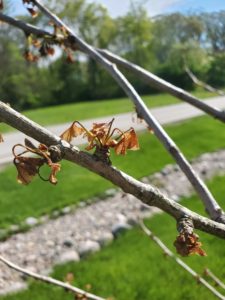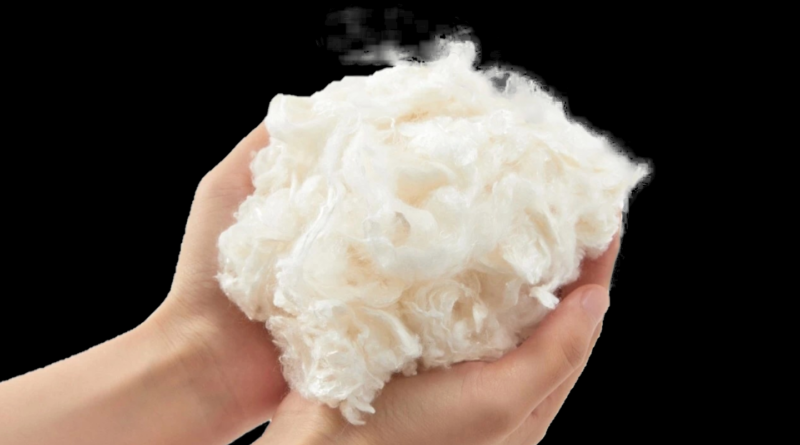Upcycling Milk Waste into Milk Tees
Podcast: Play in new window | Download (Duration: 1:33:37 — 42.4MB)
Subscribe: Apple Podcasts | Spotify | Android | iHeartRadio | Podchaser | Email | TuneIn | RSS | More
(May 31, 2020) We’ll tell you the story of upcycling milk waste into milk tees in a moment. First, though, we welcome our arborist buddy Skeet back to the show. Skeet works out of the Bolingbrook office for Bartlett Tree Experts, the primary sponsor for The Mike Nowak Show with Peggy Malecki. And though he was last on the program at the end of November, it seems like a zillion years ago. I think you know why.
Skip to a specific segment in this podcast.
7:00 Skeet from Bartlett Tree Experts
55:34 Robert Luo of Mi Terro
1:12:33 Meteorologist Rick DiMaio
Skeet will be joining us on Zoom this morning, but we might see what we call his “critter carnival.” He loves to parade insects and examples of disease-infected plants into the studio. Of course, we haven’t been in studio in almost three months, so the carnival will be virtual today.
 May has been a weirdly exciting horticultural month–for all the wrong reasons. “The Mother’s Day Freeze of 2020” is likely to be remembered for years. Scores of records were set across the northern tier of states, from the Mississippi River to New England. That includes the Chicago area, too, where temperatures were colder than on Christmas Day of 2019. As Skeet’s photo on the left show, the emerging, tender leaves on some ginkgos were blasted. Scott Jamieson from Bartlett says the good news is they are seeing re-sprouting. But it’s always iffy because trees don’t like to push two sets of leaves in such a short time.
May has been a weirdly exciting horticultural month–for all the wrong reasons. “The Mother’s Day Freeze of 2020” is likely to be remembered for years. Scores of records were set across the northern tier of states, from the Mississippi River to New England. That includes the Chicago area, too, where temperatures were colder than on Christmas Day of 2019. As Skeet’s photo on the left show, the emerging, tender leaves on some ginkgos were blasted. Scott Jamieson from Bartlett says the good news is they are seeing re-sprouting. But it’s always iffy because trees don’t like to push two sets of leaves in such a short time.
Many of us have already forgotten that freeze, as record rains have hit much of the Midwest since then. In Chicago, this month will go down in history as the wettest may ever, with 9.50 inches of rain. And, as meteorologist Rick DiMaio notes, it is the 12th wettest month in our recorded history, which includes 1788 months!
As you can imagine, that is also leading to some tree issues. Skeet says that many folks are seeing anthracnose, a fungal disease often associated with ash and sycamore trees. As he writes, scab and rust diseases are also appearing. But the COVID-19 pandemic is causing some problems for arborists.
We have already started to see Crabapple trees with Scab and Rust leaf fungus. With over 350 varieties of Crabapple, each will show different susceptibility to the diseases. With many people at home, trying to foliar treat Crabapple trees with cars in a townhome or condo is very difficult. We tried posting notes to move cars at one association, and our truck could not fit down the street. Thank goodness there was no need for emergency personnel or equipment.
I’m interested in asking Skeet what it’s been like for him to do his job during the pandemic. Who knows what else we’ll discuss? Of course, your questions are always welcome.
Upcycling milk waste is a real thing
And now, on to upcycling milk waste. To people in America’s various food industries, I suspect that 40% is a well-known number. It’s the amount of food, in all its forms, that is wasted every year. We talked about that with Gary Oppenheimer from AmpleHarvest.org just a few weeks ago.
According to the USDA, 40% of our food worth an estimated $161 billion was never harvested, lost in processing, thrown away in restaurants and homes or ended up rotting in America’s landfills and according to the Natural Resource Defense Council (NRDC) 2012 and 2017 reports, 50% of our produce is never consumed. Meanwhile, millions of Americans are not sure where their next meal is coming from.
Oppenheimer and his colleagues are working hard to get that food to people who need it. However, Mi Terro is a company that is trying a different tack. As they announce on their website,
We use biotechnology to re-engineer food waste into sustainable fibers that can replace plastic in the fashion, medical, and packaging industries.
Led by 25-year-old Robert Luo, this brash start-up company is less than two years old. Yet, it is already working with companies like Nike, Danone, H&M, Ralph Lauren, Dairy Farmers of America (DFA) and more. In fact, DFA just announced that Mi Terro will be part of its 2020 Accelerator Class.
Forbes is just one of the publications that is giving plenty of media love to this company.
“Do you know that 128 million tons of dairy products are dumped every year globally? I am really upset by such a tremendous amount of dairy waste,” Mi Terro founder Robert Luo explains to me, “our goal is to educate the public that we are consuming too many dairy products and we need to cut down on our food waste.” In his bid to tackle the waste from the dairy industry, the sustainable entrepreneur saw an opportunity to upcycle the unused milk that would be thrown out and turn it into a high-quality shirt.
Business insider picks up the story.
Mi Terro begins the milk shirt-making process by sourcing excess milk from partnering dairy farms. From there, the milk is fermented and skimmed to remove the fat in the milk. The milk is then de-watered, forming a powdery substance. The milk powder is then dissolved once again to purify it and remove unwanted proteins, leaving resulting fibers that are stretched and spun into yarn.
To make a shirt out of the processed milk threads alone would make the shirt largely unaffordable, Luo said, so it is combined with micromodal — an organic material made of beech wood, similar to cotton but with more sustainable manufacturing. Each shirt is made up of about 15-20% milk, Luo said. According to the Mi Terro website, about 5 shirts equate one glass of milk.
Yahoo News adds this information.
The combined processes result in a material that is flexible for comfort and breathable, making it a great option for t-shirts. The team soon realized that these qualities made it a good option for other clothing, too, which is why they’ve since added underwear to their wardrobe of products. And since milk is naturally antimicrobial, the shirts are also anti-bacterial and repel smells common when working out or sweating on a hot day. Claiming to be three times softer than cotton, wearers describe the Limitless Milk Shirt as silk-like, soft, and stretchy.
With the goal of complete comfort in mind, the Milk Shirt is manufactured with premium threads and seamless design to avoid any rubbing or skin irritation and encourage a long-lasting product.
In addition to using a waste product productively, upcycling milk waste require less water than cotton, and don’t utilize the pesticides and other chemicals required to grow that crop. Mi Terro plans to add other types of clothing to their line. By the way, if you’re concerned about sustainability in the “fast fashion” industry, so are we. It is reassuring that H&M, mentioned earlier, is getting better at transparency, as indicated by this story in The Guardian.
Transparency is key to the creation of a cleaner, greener fashion industry, given its particular reliance on complex, multinational supply chains. These make it difficult for customers to make ethical choices and for stakeholders to hold brands to account when things go wrong.
The index was launched as part of Fashion Revolution week, a series of events that commemorate the 2013 Rana Plaza disaster, when a large textiles factory collapsed in Dhaka, the capital of Bangladesh, killing 1,134 people.
Another of Mi Terro’s partner, Ralph Lauren, is also getting more serious about sustainability.
Meanwhile, now through June 11, Mi Terro is are working with Operation Food Search to donate 20 meals to a child in need for every purchase. In addition, they are partnering with Eden Reforestation Projects to plant 10 trees for every shirt sold.
Robert Luo joins us on the show this morning. And if you’re already intimidated, you should know a little bit about his background. He sold his first company for $300,000 while he studied at the University of Southern California. He is a fellow of the Royal Society for the Encouragement of Arts, Manufactures and Commerce. He is a Forbes Under 30 Scholar and Global Shaker’s Sustainable Fashion Innovator 2019. He is the youngest Entrepreneur Hall of Fame at the University of Southern California Marshall School of Business. He is a recipient of “25 Under 25” by Social Entrepreneur Magazine. He is also a recipient of the All America Chinese Youth Federation “Top 30 Under 30”. He is also a GreenBiz “30 Under 30” honoree.
So Robert Luo is upcycling milk waste and turning it into quality clothing. Hey, I took out my recycling yesterday. Does that count?

